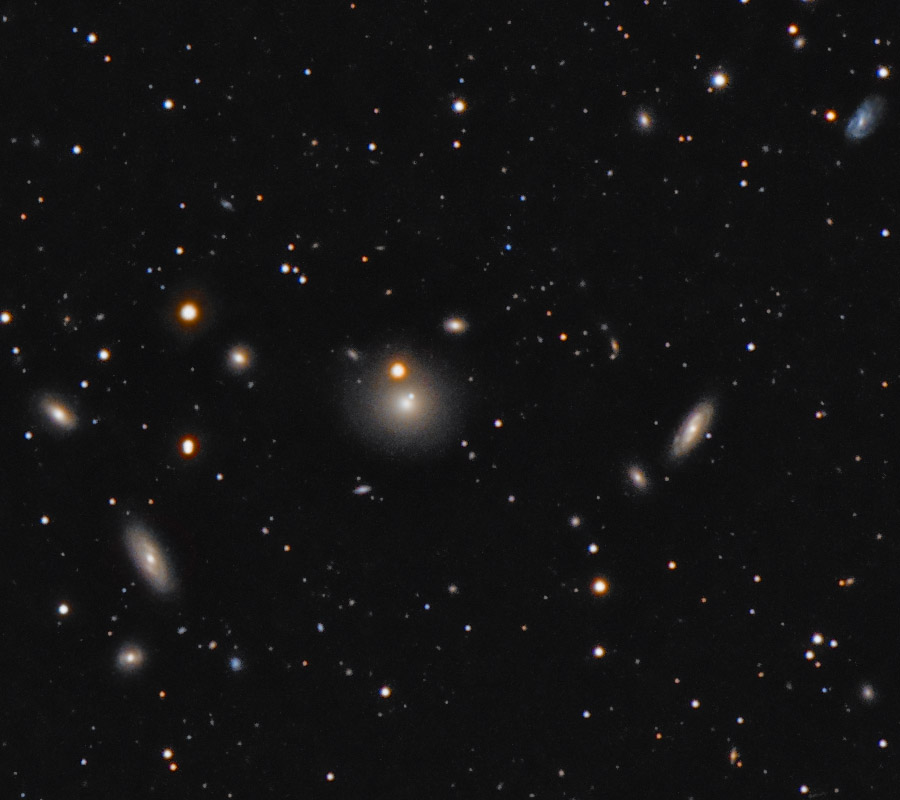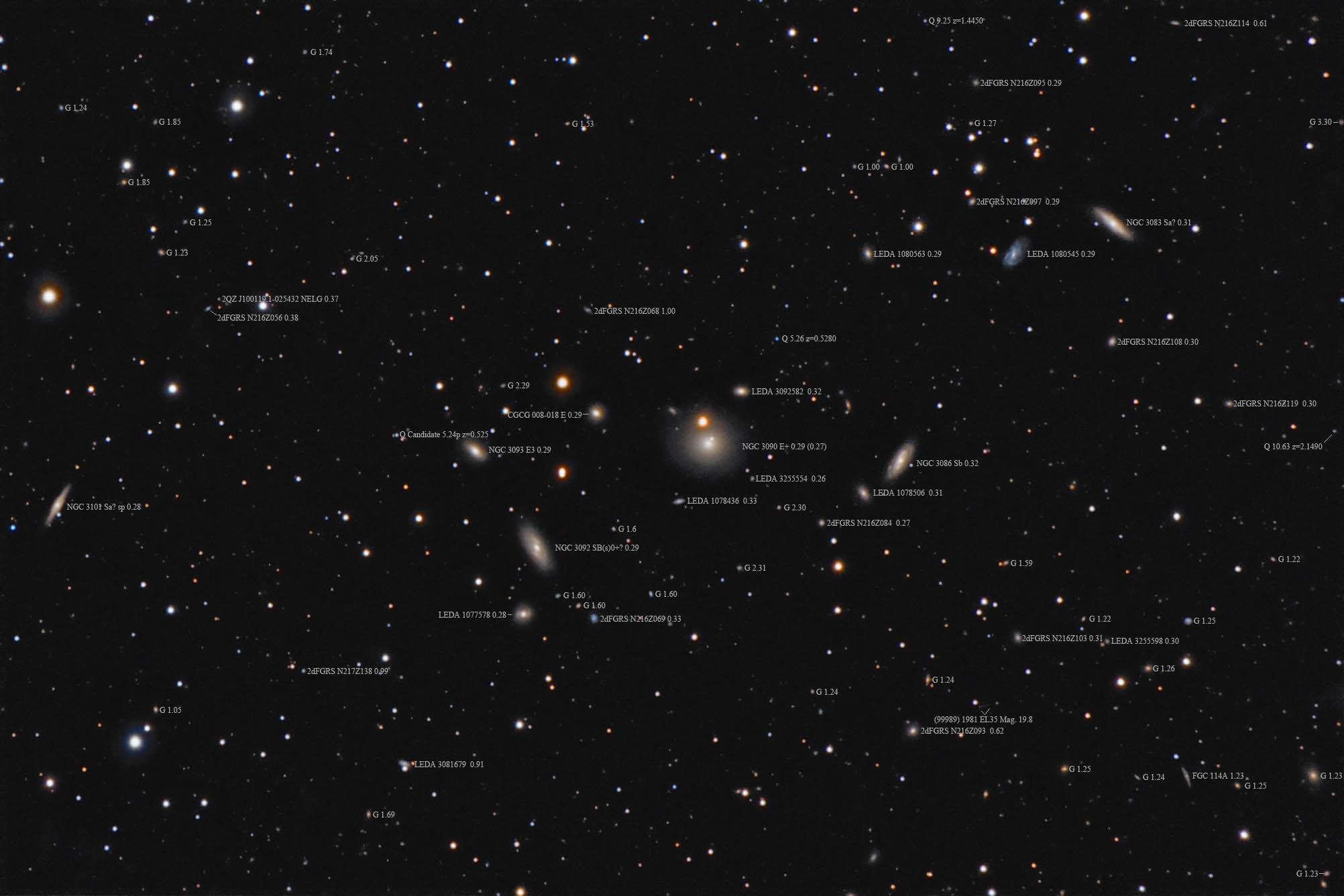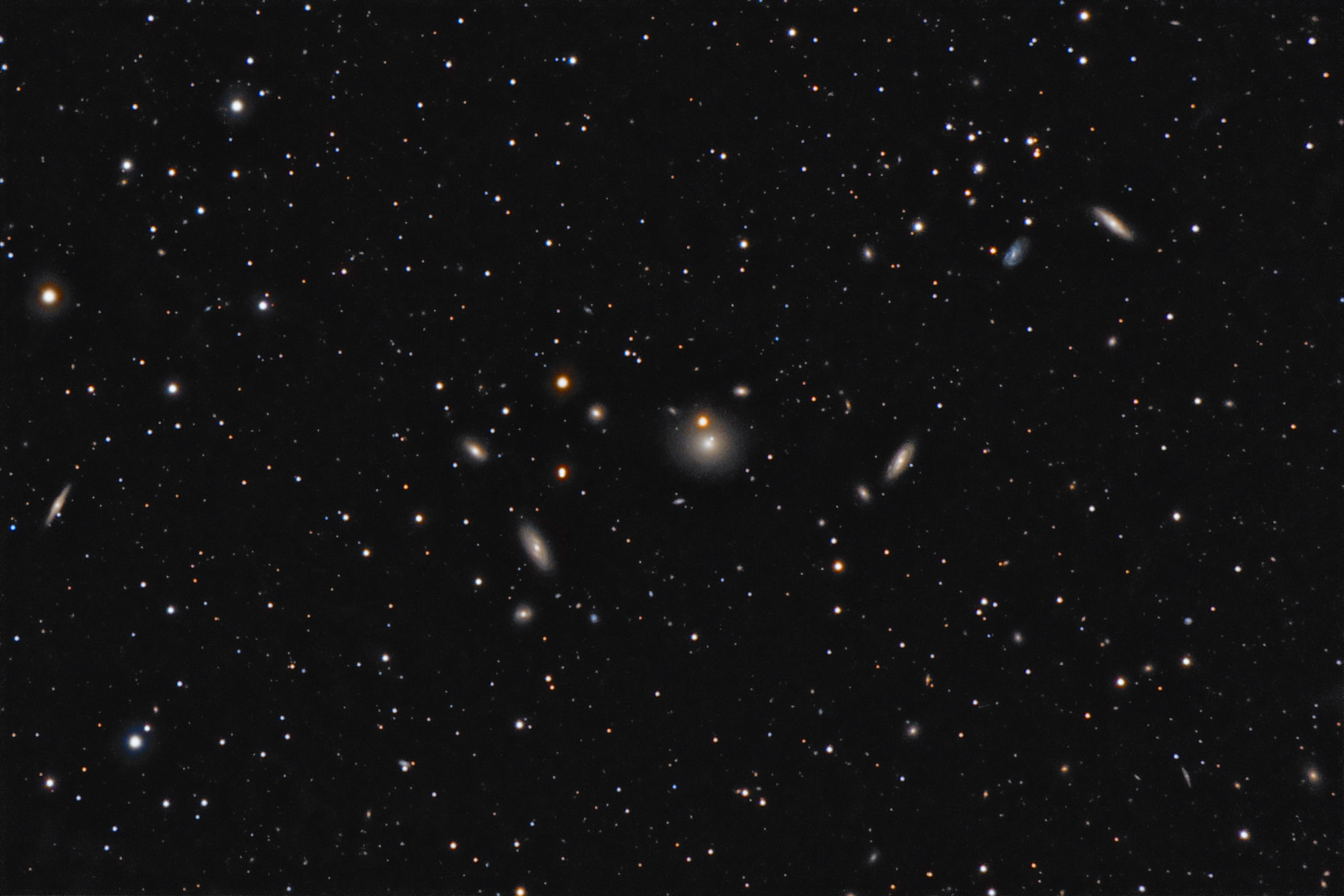| Description | Images |
Object name: NGC3090Designation(s): NGC3090, NGC3083, NGC3086, NGC3092, NGC3093, NGC3101, NGC 3090 appears to be the anchoring galaxy for a loose group of galaxies about 300 million light-years from us. I find two groups listed at NED, WBL 248 consists of the 7 major galaxies in the group while MZ 03587 more than doubles that number considering the many small dwarf galaxies in the group that are almost starlike in my image. NGC 3090 is a huge elliptical galaxy. Assuming its redshift look back time is right at 290 million years then the galaxy is 200,000 light-years across. Its outer regions sort of fade away making it hard to pin down a size though the eastern edge seems rather sharp as if it is an arc of a shell left over from one of the many mergers that likely created this large galaxy. I find very little on this group in the literature, however. It seems to have only one galaxy still giving birth to stars at a decent rate, that is LEDA 1080545, a very blue spiral that really stands out among the field of rather red and dead galaxies that make up this group. FGC 114A in the lower left corner appears rather warped to my eye. A surprising number of them in my images seem curved like this one. Rarely is a disturbing galaxy in the area. This time there are several small galaxies at about its distance nearby though none look disturbed. A few are rather dense so might be able to warp a low mass flat galaxy without being noticeably distorted in the process. All of the NGC galaxies were discovered by Albert Marth on January 22, 1865. Related Designation(s):2dFGRS N216Z066, 2dFGRS N217Z134, 2MASS J09594966-0252388, 2MASS J10001098-0258342, 2MASS J10003023-0258084, 2MASS J10004742-0300446, 2MASS J10005358-0258192, 2MASS J10013542-0259400, 2MASX J09594966-0252383, 2MASX J10001097-0258343, 2MASX J10004745-0300448, 2MASX J10005359-0258188, 2MASX J10013544-0259400, 2MASXi J0959496-025238, 2MASXi J1000109-025834, 2MASXi J1000474-030045, 2MASXi J1000535-025819, 2MASXi J1001354-025940, 2MFGC 07763, 2PIGG NGPGAL B+2.61083-0.04767, 2PIGG NGPGAL B+2.61387-0.04806, 6dF J0959497-025239, 6dF J1000110-025834, 6dF J1000474-030045, 6dFGSv 05115, 6dFGSv 05122, 6dFGSv 05131, APMUKS(BJ) B095738.94-024409.4, APMUKS(BJ) B095758.30-024328.8, APMUKS(BJ) B095815.46-024618.3, APMUKS(BJ) B095821.49-024352.2, APMUKS(BJ) B095903.36-024513.3, CGCG 008-011, CGCG 008-012, CGCG 008-016, CGCG 008-019, CGCG 008-021, CGCG 008-024, CGCG 0957.3-0238, CGCG 0957.6-0244, CGCG 0958.0-0243, CGCG 0958.3-0246, CGCG 0958.4-0243, CGCG 0959.1-0245, EON J150.398-02.994, GALEXASC J095949.70-025238.7 , GALEXASC J100011.08-025833.3 , GALEXASC J100053.53-025818.8 , GALEXASC J100135.48-025942.2 , GSC 4899 00406, GSC 4906 00102, GSC 4906 00274, GSC 4906 00284, GSC 4906 00505, GSC 4906 00548, HDCE 0557 NED001, HDCE 0557 NED002, HDCE 0557 NED003, HDCE 0557 NED004, HDCE 0557 NED005, LDCE 0693 NED001, LDCE 0693 NED002, LDCE 0693 NED004, LDCE 0693 NED005, LDCE 0693 NED006, MCG +00-26-002, MCG +00-26-003, MCG +00-26-005, MCG +00-26-007, MCG +00-26-008, MCG +00-26-011, NGC 3083, NGC 3086, NGC 3090, NGC 3092, NGC 3093, NGC 3101, NGC3083, NGC3086, NGC3090, NGC3092, NGC3093, NGC3101, NPM1G -02.0249, NSA 136344, NSA 136362, NSA 136372, NSA 136380, NSA 136383, NSA 136408, NVSS J100030-025808, PGC 028900, PGC 028924, PGC 028945, PGC 028967, PGC 028977, PGC 029025, SDSS J095949.67-025238.9, SDSS J100010.99-025834.2, SDSS J100030.23-025808.4, SDSS J100047.43-030044.5, SDSS J100053.58-025819.1, SDSS J100135.43-025939.9, UZC J095949.7-025239, UZC J100011.0-025834, UZC J100030.2-025809, UZC J100047.5-030046, UZC J100053.5-025819, WBL 248-001, WBL 248-002, WBL 248-003, WBL 248-005, WBL 248-006, WBL 248-007, [KG2002] J095949.86-025239.2 , [KG2002] J100011.06-025835.7 , [KG2002] J100030.33-025810.4 , [KG2002] J100047.52-030047.4 , [KG2002] J100053.75-025820.0 , [KG2002] J100135.48-025942.5 , | Permanent link: https://images.mantrapskies.com/catalog/NGC/NGC3090-NGC3083-NGC3086-NGC3092-NGC3093-NGC3101/NGC3090L4X10-RGB2X10R-CROP.JPG |


